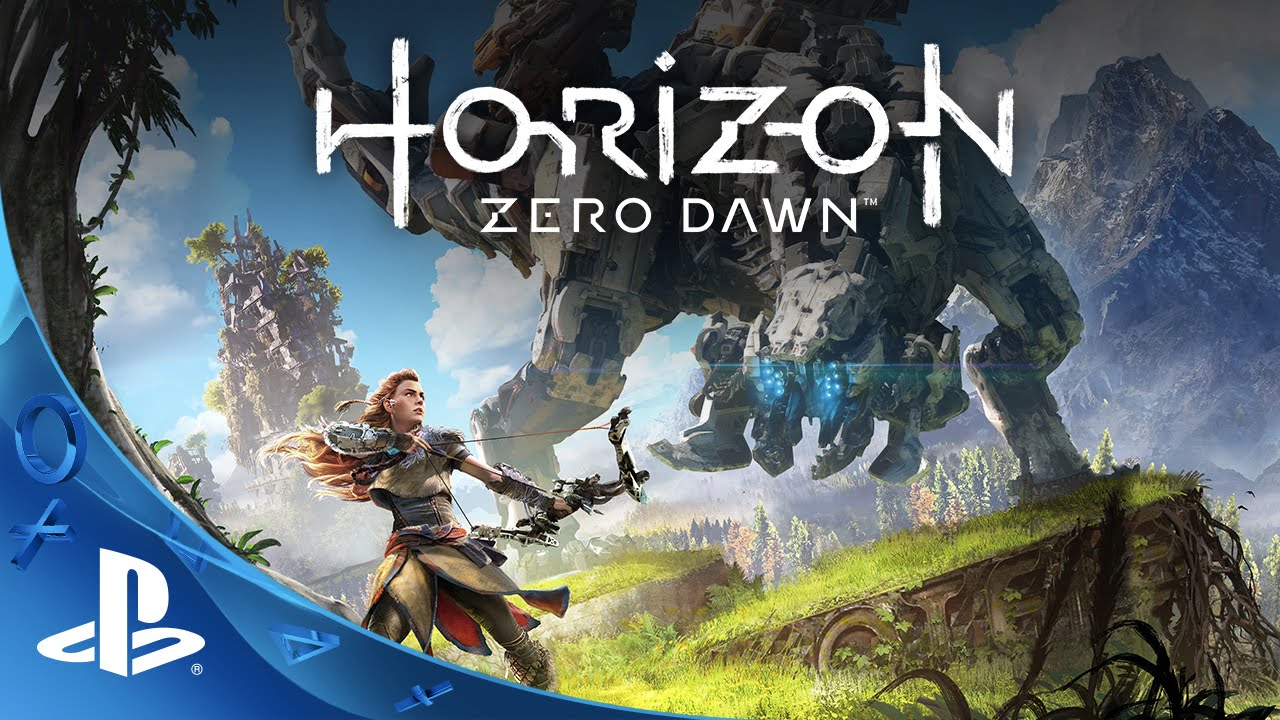Though we may joke about a robotic uprising, it’s not a topic that Guerilla Games’ latest effort takes lightly. In fact, Horizon: Zero Dawn — a game that is set on this very planet, in the extremely distant future — bases itself around and pits the player against sentient beings made up of metal, wire and computer chips. Beings that were created by humanity’s many hands and manufacturing plants.
In this battle between man and machine, we find Aloy (“Eh-loi”), a redheaded outcast from the otherwise peaceful Nora tribe. Forced to live outside of the colony, with her faithful protector and adopted father Rost by her side, she’s shunned by anyone she comes in contact with and doesn’t understand why. After all, it’s not as if she chose this life, nor was it her choice to be labelled as a child without a mother, which is something else that she simply doesn’t understand at her young age.
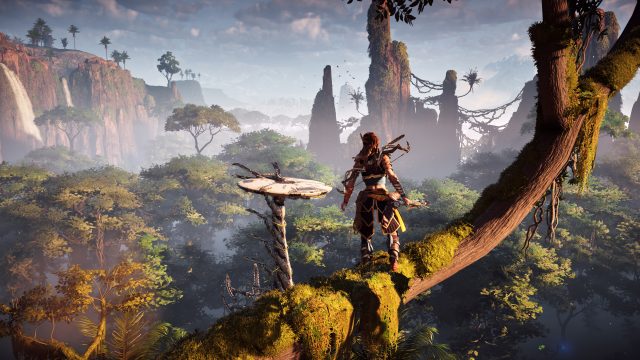
Despite being forced to fend for themselves with little help from the primitive, tribal society surrounding them, Aloy and Rost seem to live a rather peaceful and close life. They look out for one another and hunt together, with the older Nora doing everything he can to teach his young ward how to avoid danger by hiding in long grass and striking when the moment is right. Sure, there’s sadness to be found in Aloy’s eyes and words, but it’s not something that propels her until one fateful day when she falls into a cave, stumbles upon relics of a lost civilization, and discovers a computerized earpiece that shows her things she’s never before imagined. Things like robots’ paths and weaknesses, ages old audio and video diaries, and both the tracks and blood splatter left behind by other human beings.
It’s this very discovery — the result of an accidental fall and the need to get back to solid ground — that ends up changing Aloy’s life forever, and pits her into a quest that will forever change the world around her. One that, as much as I’d love to, I can’t say a lot more about, because Horizon: Zero Dawn‘s narrative is so easy to spoil. Let it be known, though, that those who undertake this primitive quest are in for an interesting, thought provoking and memorable ride, that will make them question humanity as a whole.
That said, while giant animal and dinosaur-like robots do walk the earth, most threatening the lives of any who get in their way, they are not the only enemy in this overgrown version of post-apocalyptic earth. As you might expect, the different tribes that now inhabit it — each with their own beliefs, such as the Nora’s devout allegiance to a god called the All-Mother — don’t exactly get along. There’s tension in the truces, and there are those who play by no rules and inhabit outposts that double as jails for those they’ve captured. It’s a tumultuous world out there, needless to say, and one that Aloy must try to help in the process of trying to find out where she came from.
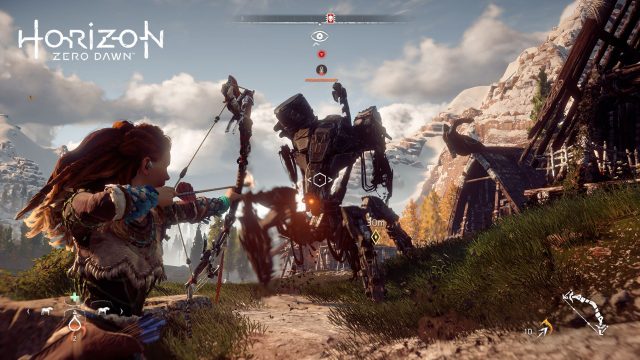
Those who’ve been following Horizon: Zero Dawn for the last couple of years will have a good idea of what they’re getting into based on the trailers, gameplay footage and interviews that have been released. However, for those who are new to the fold, as well as those who’d like some more explanation, here’s how things play out.
At its core, this is an open world action/RPG hybrid. A game that allows you to go wherever you wish and do whatever you’d like, as you venture throughout its gigantic open world. What sets it apart from every other game out there, though, is that this massive landscape is home to a plethora of different mechanical creatures, many of which are based around bulls, deer, ostriches, crocodiles and (giant) birds. It’s these unnatural beings that you’ll do the majority of your battling with, both on the offensive and defensive side of the equation.
In most cases, these robotic beasts remain docile unless they feel threatened by your presence, meaning that you’ve either attacked them or come close to them. It’s always important to be wary, though, because alerting even the smallest mech can lead to an epic confrontation against multiple hulking foes.
The smallest of these robotic designs happens to be the Watcher, a quick, nimble, long-necked variation that uses its large lens and advanced radar to scout for threats. If they sense you, they will pounce, shoot at or attempt to blind you, and will alert everything nearby. As such, using Aloy’s bow and arrows to silently dispatch of these annoyances is a major key to survival, especially early on when they pose more of a physical threat. One good shot to the lens (or eye, if you will) usually renders them disabled, allowing you to quietly approach and dismantle their parts for later use.
Every mech is different, though, and there’s even one (the deer-like Grazer) that will run from you, instead of running towards you with hatred in its ‘eyes.’ For this reason, it’s important to always be strategical whenever you come across a single beast, or a group of the things.
In addition to looking and acting differently, they all have their own strengths, elemental weaknesses and glowing spots that can be shot at for extra damage. Of course, seeing all of these things isn’t possible with the naked eye, and can only be accomplished by pressing the right joystick in and using Aloy’s earpiece to scan everything she’s up against.
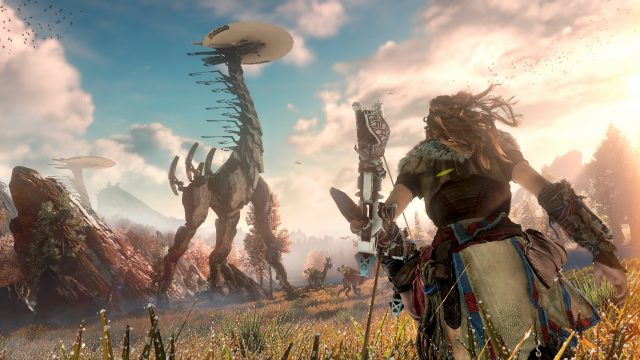
You’ll begin with, and become good at using Aloy’s trusty bow and its basic arrows, before graduating to fire arrows. This isn’t a weapon that you will stick with full-time, however, as there are many merchants spread throughout the land, all of which sell different types of weapons, each with their own statistics. There’s the sharpshooter bow variant, which is slow but more powerful and comes in handy whenever you want to land a headshot; the sling, which throws elemental bombs; the tripwire, which does as its name suggests and lets you place rope-based traps; the roper and its ability to tie enemies down; and the rattler, which acts as a close range machine gun of sorts.
While almost all of those weapons can be purchased from just about any vendor, what separates each one’s stock is its rarity. Base versions of said death dealers may be common, low priced and easy to find, but different tribes have their own versions and it all culminates in a shadow variant that offers optimum quality. That said, getting these rare weapons isn’t as simple as scrounging up enough money (metal shards in this case) and then handing it to your merchant of choice. No, that would be too easy.
What’s important to know about Horizon: Zero Dawn is that, while it has the combat and open world feel of games like Rise of the Tomb Raider and The Witcher III, for example, it also has an emphasis on looting and crafting that is similar to what you’d find in a Far Cry game. As such, looting every downed enemy is almost a necessity, with each one offering unique parts based on its type. These parts, then, are used for both manufacturing ammunition and trading with merchants, who will often require a special trade for advanced weapons and unique, perk-offering outfits.
If you’ve never been one to enjoy looting downed enemies or scrounging the environment for plants (used for healing, and for the creation of potions that help you avoid elemental damage for a limited amount of time), then Horizon: Zero Dawn may not be the game for you. Looting is so heavily ingrained in its gameplay that it becomes habit, sometimes to the point of annoyance. It’s a necessity, however, because you’re not going to get far if you don’t do it. I mean, even your trusty arrows require crafting, with wood harvested from small trees being their most vital component.
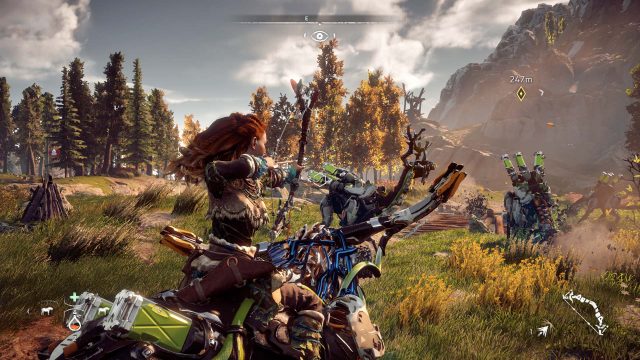
On tougher difficulties, picking the right weapon for each encounter is also a key to survival. Stunning, freezing or lighting your enemies on fire can change the tide of a challenging battle, as can laying traps around the environment. Be warned, though, that all traps you lay are permanently placed unless you’ve put a decent amount of time into the game and have unlocked the ability to dismantle them. It’s one of many perks and skills that can be earned by leveling up within a structure that awards you with experience points for absolutely everything you do.
There’s a Hell of a lot to do in Horizon: Zero Dawn, too, which will make you want to revisit the world even after you’ve completed its lengthy and memorable campaign.
In addition to its main quest line, Guerilla Games’ latest offers two different types of secondary missions: side quests (which are involved and are usually made up of several steps), and errands (which are more like favours, and are reminiscent of basic side quests found in traditional RPGs). Along the way, you’ll also come across many other opportunities, including guarded outposts to take over, hunting grounds full of trials, tallnecks to climb and hack (to flesh out the map) and ancient factories to explore. It’s there, in those ‘cauldrons,’ where Aloy will discover how the robots were crafted and why they were made. Not only that, but making your way to the heart of each cauldron will allow you to learn how to hack and mount(!) the different types.
Needless to say, it’s easy to become lost in and immersed within Horizon: Zero Dawn, to the point where you’ll look at your save file and see that thirty or forty hours have passed. Just roaming around the massive map, with its forest, desert and arctic environments is a joy, as is watching the game’s gorgeous world react to its stunning day/night and weather cycles. There’s always something to find in the form of historical logs and collectibles, too, and it’s not hard to spot animals (boars, turkeys, fish, geese, rabbits and raccoons) to hunt. Killing and skinning these real-life creatures is always beneficial, because their meat, skins, bones and talismans can be used to craft additional storage space, trade with merchants, or make special items.
As you progress, you’ll establish relationships with different people, choosing how to interact with them through a somewhat basic, but effective dialogue system. At times, these decisions will change how things play out, such as turning a former enemy into a new ally who will help you with your quest.
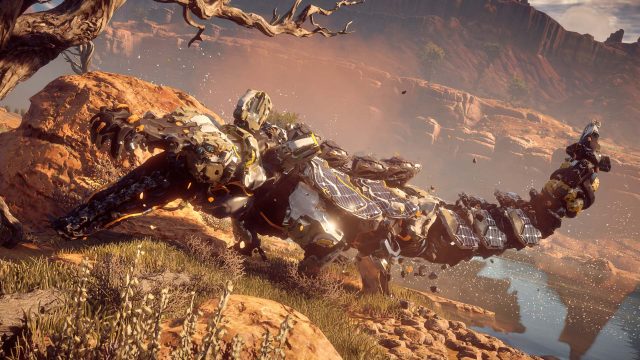
That said, as good (and as stunning) as Horizon generally is, it isn’t without its faults. Some of its facial animations can look a bit off during cutscenes and conversations, the human enemy AI often leaves something to be desired, and there’s no real lock-on, although that could have been intentional since this is a game that promotes picking robotic enemies apart piece by piece and collecting their parts. Perhaps the biggest downside, though, apart from the AI troubles, is the melee combat. Aloy’s spear is helpful and can be effective during combat, but its mechanics can sometimes be a hindrance and a frustration, especially after you unlock the heavy strike. I can’t count how many times I accidentally did a heavy strike after shooting an arrow, because both were mapped to the same button.
Whenever you get into battle against multiple enemies, it’s sometimes safer to run, because Horizon is at its best when it’s just you against one or two foes. When lots come into play, it can become a bit muddied, and dodging around the environment while avoiding attacks can become a bit disorienting. There’s definite room for improvement here, and in the other aforementioned areas of the game, but this is also a new IP and a very big undertaking for a developer that used to make its money creating first-person shooters in the Killzone franchise. With what they’ve done here — especially as a first crack at a gigantic, open world game — lots of credit is owed and deserved, even if the final product has a few hiccups and isn’t the most original experience of all-time.
Horizon: Zero Dawn will certainly make waves, though, and not just for its quality and immersive gameplay. That’s because it’s not only fun to play, but also an absolute treat for the eyes and ears. Stunning to the point of being jaw dropping, with a great photo mode to boot, it’s easily one of the best-looking video games in existence and a bonafide showcase for the PlayStation 4 Pro. Sure, it may be 30 frames-per-second, which will disappoint some, but it’s gorgeous and suffers from very few drops or glitches. I did encounter a few, though, including one occasion where the game crashed to the system’s dashboard and needed to be restarted.
On the other side of the coin lays the audio, which is almost as much of a standout as the visuals it accompanies.
Ashly Burch, who voices Aloy, does an incredible job of bringing life to the curious, boisterous and unwavering heroine. She’s joined by a generally fantastic cast of supporting players, who combine to make this overgrown and futuristic earth a believable place. The explosive, mechanical and utterly guttural sound effects also aid this cause, by making combat both an exhilarating and frightening experience, where unexpected enemies can come out of the woodwork at any moment. The world itself is a real standout, though, thanks to its environmental variety and its well-placed relics of yesteryear, like overgrown and rusted tanks or crumbling human architecture.
Horizon: Zero Dawn is the real deal, and a definite must buy for any action-loving PlayStation 4 owner. Not only is it long, full of life, and wholly immersive, it is also a stunning showcase of modern gaming.
This review is based on the PS4 exclusive, which we were provided with; we played it on a PS4 Pro.

